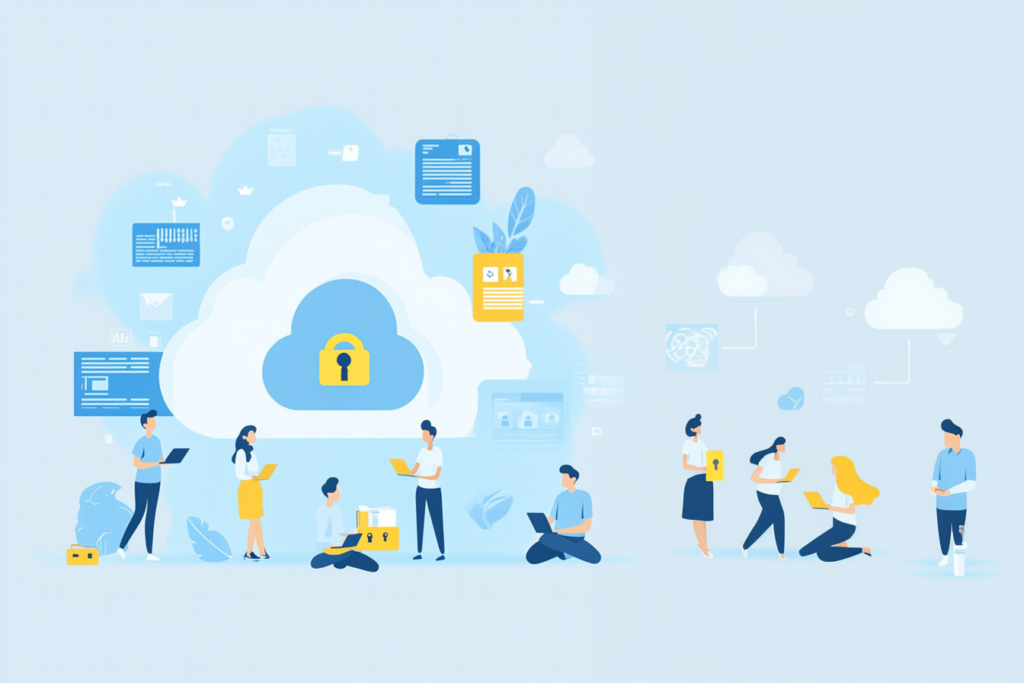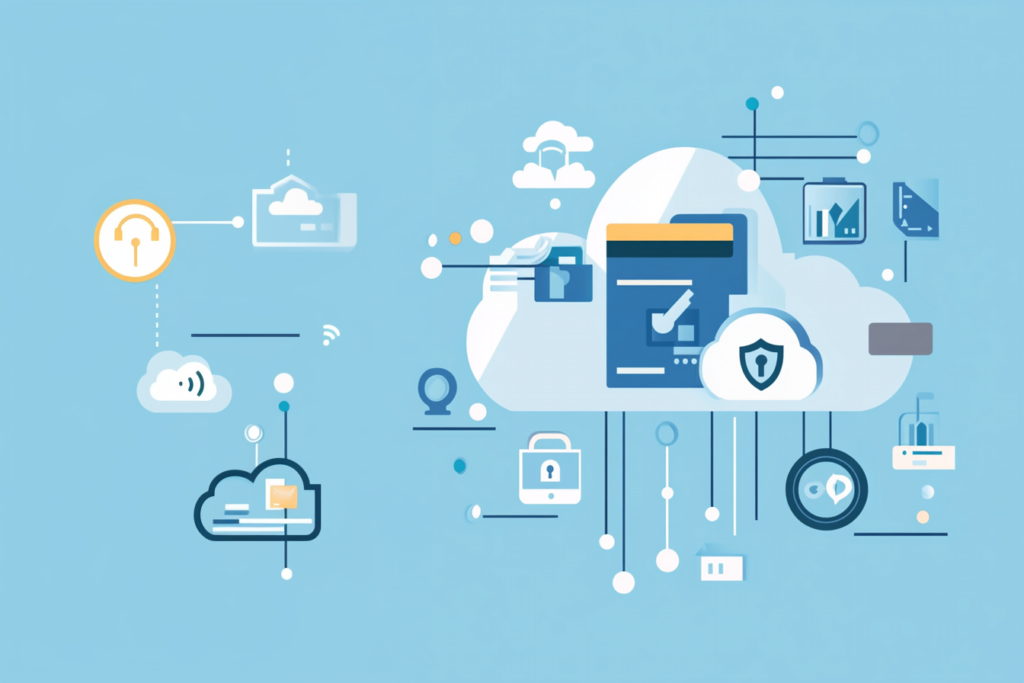According to Statista, nearly 60% of enterprise data is stored in the cloud. According to Gartner, by 2025, spending on cloud computing in system infrastructure technology, business process services, infrastructure software, and application software areas will surpass conventional IT solutions in these segments.
As the adoption of cloud services increases, so do the challenges of data protection. Businesses must take the necessary steps to secure their data to counter the revolutionizing methods of cybercriminals. Fortunately, there are several options available.

This blog highlights the six best strategies to ensure maximum data protection. But before we delve into that, we will explain data storage security in cloud computing, common security challenges in the cloud, and the key principles of data security in the cloud. Finally, we will share case studies associated with data breaches and the implementation of data security strategies.
What is Data Security in Cloud Computing?
Cloud computing is highly beneficial for businesses since it allows them to access data from any device with an internet connection. This lowers the chances of data loss during incidents or outages, an issue several ventures face.
Cloud computing aims to enhance agility and scalability. Despite its numerous advantages, many companies are unwilling to migrate their data to the cloud because they fear data security.
Cloud data security refers to the practice of protecting digital information assets and data from insider threats, human error, and security threats. It takes advantage of processes, policies, and technology to keep an organization’s data confidential as well as accessible to those who require it in cloud-based environments.
In essence, cloud data security includes:
-
Encryption configurations
-
Data transmission flows
-
Identifying and categorizing structured and unstructured data
-
Pinpointing structured and unstructured data storage locations
-
Implementing access management controls and monitoring them at the field and file levels

Apart from being important to the company, data protection in cloud computing is extremely crucial to building customer trust. According to McKinsey, customers require organizations to be completely transparent with their digital-trust policies:
-
85% of respondents stated that being aware of a company’s data privacy policies is crucial prior to buying the products or services
-
53% of respondents use digital services or make online purchases only after ensuring that the company is known for protecting consumer data
-
46% of respondents always or often consider a second brand if they are unsure about how a business will use their data
Businesses that use data privacy in cloud computing not only benefit from consumer trust but also get an advantage in terms of:
-
Avoiding fees and fines associated with data breaches
-
Protecting the brand’s reputation
-
Mitigating risks regarding data breach
Whether you are an individual or a business, cloud computing and data security are serious concerns that need special attention. It comprises several branches of cybersecurity, neglecting any of which can result in severe consequences, such as legal liabilities, loss of trust, and data breaches. Sensitive information, such as IP address, physical address, and biometric information, must be protected.

Common Security Challenges in the Cloud
Before learning the best strategies for data security and privacy in cloud computing, it is crucial to understand the common security challenges that businesses usually face in the cloud. Based on this understanding, the right strategies can be implemented.
-
Data Breaches and Leaks: Cloud data storage and cloud databases are the perfect targets for online criminals seeking a great payday, particularly when companies are not up to speed about cloud management and data handling.
-
Unauthorized Access and Insider Threats: Often, unauthorized cloud access results in critical data leakage, leading to severe consequences. Additionally, insider threats from within the company may not necessarily be malicious.
-
Compliance and Regulatory Issues: Regulatory standards vary from one industry to another and from one region to another. Additionally, compliance with major regulations like PCI-DSS, HIPAA, and GDPR needs continuous improvement and effort. It can be hectic for companies to keep up with these standards, particularly in an ever-evolving cloud environment.
-
Data Loss and Availability Concerns: Data loss can occur due to corrupted data, accidental deletion, cyberattacks, and hardware failures. Once the data is lost, recovering it can be extremely difficult or impossible. Additionally, data may not be accessible in cases like data lock-in and DDoS attacks.
Key Principles of Data Security in the Cloud
Confidentiality, integrity, availability, and compliance are the four key pillars that portray the major concepts of a business’s security program. Any security incident, vulnerability, or attack will violate one or more of these principles. Hence, security professionals utilize this framework to determine potential risks to a company’s data.
-
Confidentiality
How to secure data in cloud computing? To ensure confidentiality, businesses must ensure that sensitive information is accessible only to authorized users. Only allowing authorized people and processes to access and modify the data helps keep it private.
-
Integrity
Cloud computing, as well as analytics, helps businesses make decisions that are driven by data. Thus, businesses must maintain the accuracy and completeness of data in order to ensure data integrity. This can be done by implementing measures or policies that prevent the company’s data from being deleted or tampered with.
-
Availability
Even though companies are required to deny unauthorized access, data must still be accessible and available to authorized individuals and processes when needed. Hence, businesses must keep devices, networks, and systems running smoothly and ensure continuous uptime.
-
Compliance
Compliance involves adhering to relevant laws, regulations, standards, and practices to ensure data protection and responsible data management. Compliance with regulations like GDPR (General Data Protection Regulation) and HIPAA (Health Insurance Portability and Accountability Act) generally requires stringent measures.
How to Secure Data in the Cloud: 6 Strategies
Now that you are aware of all the reasons why a company must protect its data in the cloud, it is time to learn how to protect cloud data. Below are six key strategies to achieve this. You can also learn how to create a robust cloud data management strategy in our blog.
-
Data Encryption: In any cloud computing environment, data must be encrypted during transit and at rest. This involves the implementation of TLS/SSL protocols when necessary, properly managing keys, and using robust algorithms like AES-256.
-
Access Control and Identity Management: An access control system with permissions based on roles allows authorized individuals to access sensitive information. For added security, authentication must take place through MFA or multi-factor authentication. The establishment process also involves creating and managing user accounts and setting permissions.
-
Regular Security Audits and Assessments: These involve regular review and evaluation of the security measures within the cloud environment. This approach helps identify and address possible vulnerabilities to ensure data security in the world of cloud computing. This strategy includes continuous monitoring, compliance audits, penetration testing, and vulnerability assessments.
-
Data Backup and Disaster Recovery Plans: Data backup and DR plans are among the most essential components of cloud security since they ensure that data can be restored even when there is a cyberattack, system failure, or data loss. Such strategies help in reducing downtime and ensure business continuity.
-
Compliance and Regulatory Adherence: Compliance refers to ensuring that the company’s cloud security practices align with relevant industry, regulatory, and legal standards. This is crucial for protecting data, maintaining the trust of customers, and avoiding legal penalties. Organizations must identify and comprehend the regulations that apply to their business. Additionally, they should implement relevant organizational and technical measures like regular audits and data encryption.
-
Employee Training and Awareness: Among the most crucial strategies for data protection in the cloud is the training and awareness of employees about cloud data security. The company cannot fully protect its data without the employees being aware and trained. As human error often results in security breaches, ventures must regularly train their employees on security awareness, conduct phishing simulations, explain security procedures and policies, and educate them on access control.
Case Studies and Real-World Examples
Successful Implementation of Cloud Data Security
The case studies of two major companies, Netflix and Adobe, are given below. These are examples of businesses that have successfully implemented comprehensive cloud data security measures. At the end of each case, we have also shared the lessons learned and best practices from these implementations.
Cloud computing data security also has a vital role in the healthcare industry due to an awful lot of privat information stored. To learn more about the role of cloud computing in healthcare with its pros and cons, read our blog.
Netflix
Among the largest streaming services worldwide, Netflix migrated its infrastructure to the cloud using AWS (Amazon Web Services). Considering the data security issues in cloud computing, user data sensitivity, and the scale of its operations, Netflix was required to implement robust cloud security measures, including:
-
Identity and Access Management: Netflix established a least-privilege access model to ensure that services and users only had the permissions required for their roles.
-
Encryption: Netflix ensured end-to-end encryption for all user data in transit and at rest. The company also utilized AWS Key Management Service to secure key management.
-
Automated Security Audits: Security Monkey is among the tools that Netflix developed to automate the monitoring and auditing of AWS configurations, identifying possible vulnerabilities associated with security.
The key lessons learned from this case study are:
-
Continuous monitoring is essential. Through continuous monitoring, Netflix can quickly identify and respond to any data storage security in cloud computing issues.
-
Automation is key. Automating security processes, like configuration checks and audits, reduces human error risks.
Additionally, we also learned some of the best practices from Netflix’s security measures:
-
Least Privilege Access: Strictly adhering to the least privilege access can significantly reduce the risk of unauthorized access.
-
Use of Custom Tools: Adopting or developing custom tools particularly tailored to the needs of the company’s cloud environment can substantially improve security.

Adobe
Several of Adobe’s services, like Creative Cloud, were transferred to the cloud. Considering the necessity of protecting user data and creative assets, Adobe implemented robust cloud security measures:
-
Forensics and Incident Response: Adobe formed an incident response plan comprising detailed procedures for handling data privacy in cloud computing incidents. The company also used forensic tools to identify and mitigate the impact of any security breaches.
-
Zero Trust Architecture: The company adopted a zero-trust security model, which meant verification for each access attempt to the cloud services. This was irrespective of the request origin.
-
Content Encryption: Adobe utilized advanced encryption methods to protect the content stored in the cloud. The company ensured that the content created by the users, as well as the user data, were encrypted in transit and at rest.
Following the measures taken by Adobe for data security, the lessons learned are:
-
A zero-trust model can boost security. It assumes both internal and external threats, reducing the chances of data breaches through unauthorized access.
-
Be prepared for incidents. Having an incident response plan is critical for reducing the impact of security breaches. This also helps ensure that the company will quickly recover from the incident.
Further, based on the practices followed by Adobe, some of the best practices that can be implemented are:
-
Robust Incident Response: Form an incident response plan and keep updating it to ensure the company can effectively respond to any cloud computing and data security incidents.
-
Zero Trust Security: Businesses must employ a zero-trust architecture to ensure that all access attempts are authenticated and verified, reducing any unauthorized access risk.
Data Breach Incidents
Data breaches in the cloud can lead to severe consequences, such as reputational damage, financial losses, and regulatory penalties. Some of the data breach incidents are shared below. Additionally, key takeaways and preventive measures have also been stated.
Accenture (2021)
Accenture experienced a ransomware attack in 2021, leading to more than 6TB of data leaks. The attackers gained access by exploiting vulnerabilities in the cloud environment. The incident demonstrates the increasing threat of ransomware attacks. It also highlights the significance of timely monitoring and updating cloud environments for data protection in cloud computing against vulnerabilities.
In order to prevent such incidents, companies must ensure regular patching and updates, implement backup and disaster recovery plans, and use network segmentation to limit ransomware from spreading.
Microsoft Exchange Server (2021)
Attackers gained access to install malware and email accounts by exploiting Microsoft Exchange Server in 2021. This impacted thousands of organizations across the globe, resulting in a system compromise and data theft.
Based on the incident, one of the key takeaways is zero-day vulnerability, which highlights the risks related to unpatched software and the necessity for immediate response to increasing threats. Organizations must focus on rapid patch deployment, segregation of critical systems, and threat intelligence to prevent breaches like these.
Final Word
Ensuring robust data security in cloud computing is among the most crucial aspects of using the cloud. Organizations must encrypt data in transit and at rest, limit access control based on role, conduct regular security audits and assessments, form data backup and disaster recovery plans, ensure compliance and regulatory adherence, and conduct employee training.
At LITSLINK, we understand the importance of data security in the cloud. That’s why we have a team of software development specialists who can ensure the highest level of cloud security with advanced technologies and techniques. So, if you are looking for cloud data security solutions, we are here to help. Avail of LITSLINK cloud services now.





